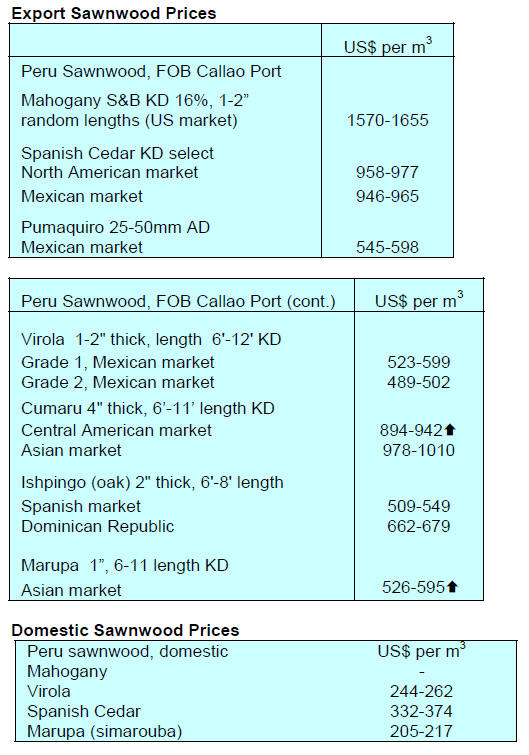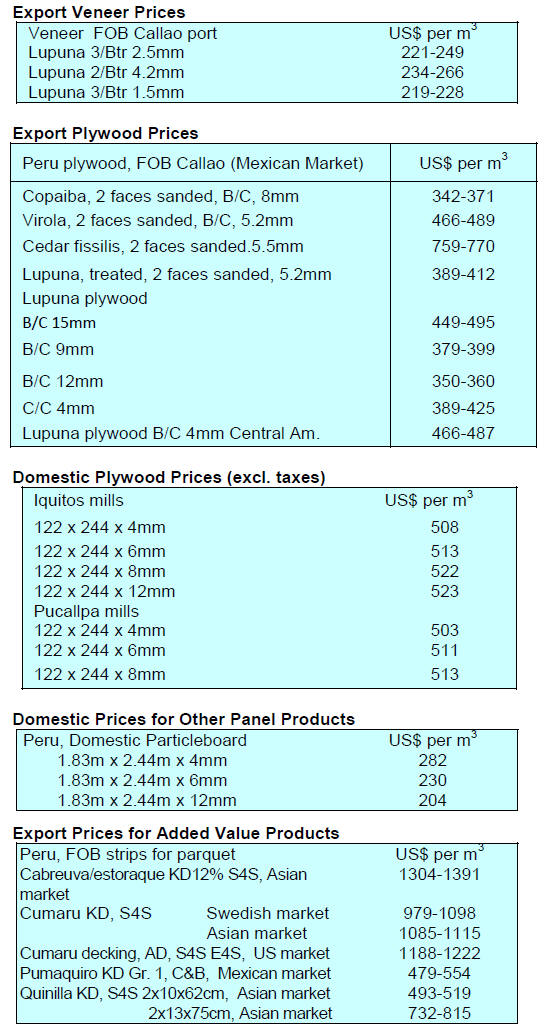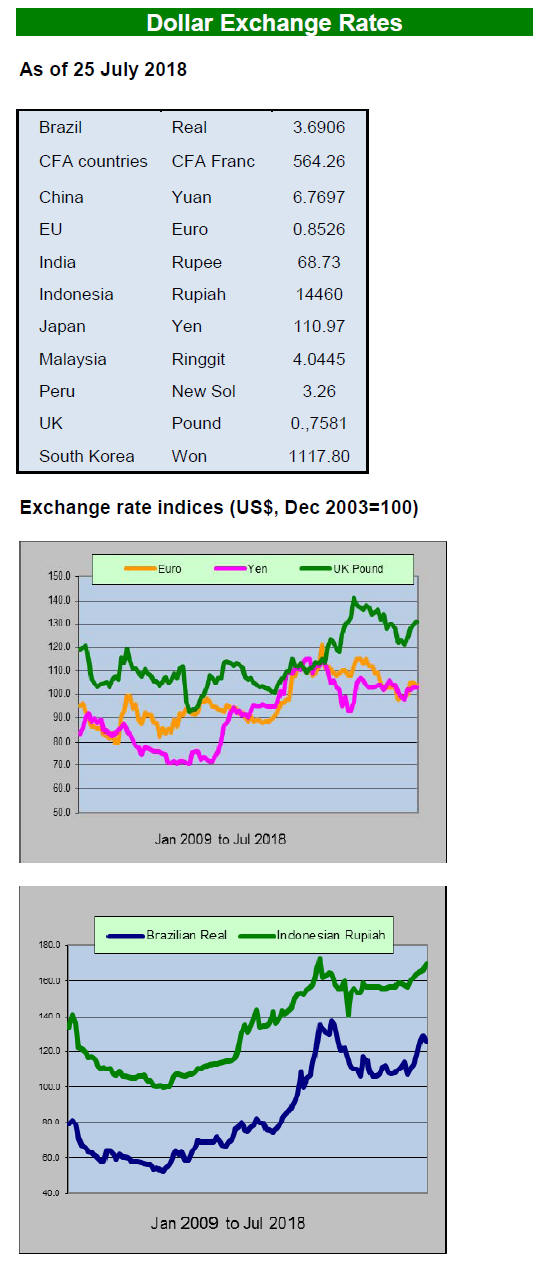2. GHANA
First four month exports surge
In the first four months of 2018 Ghana’s wood product
exports totalled 115,225 cu.m compared to 92,937 cu.m
during the same period in 2017, an increase of almost
24%.
In eight of the 18 categories of wood products exported
during the period significant increases in export volumes
were observed as shown in table below.
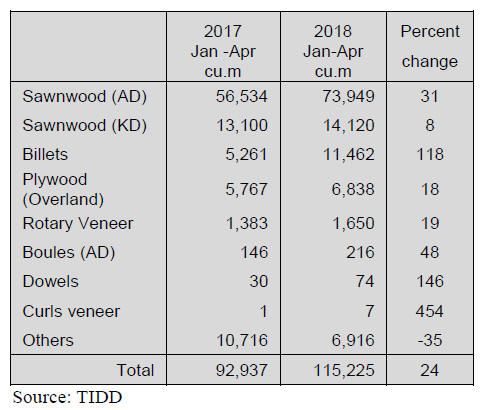
The leading species used for the production and
subsequent export shipments were teak (35%), rosewood
(14%), wawa (9.5%), ceiba (8%) and papao/apa (8%).
As has been the case for several years, markets in Asia
continue to consume most of Ghana’s wood products with
lesser volumes being shipped to European markets and the
US.
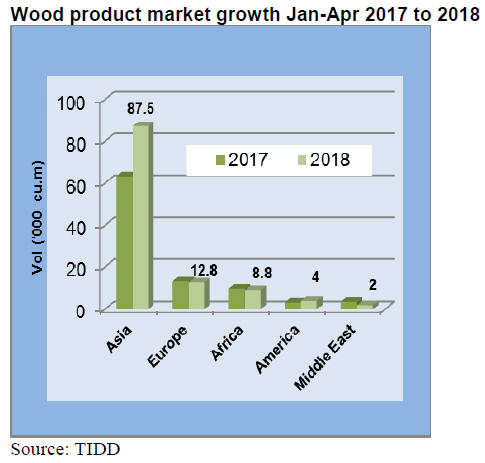
The regional ECOWAS market accounts for a
significant
part of Ghana’s total exports but in the first four months of
this year the volume shipped to ECOWAS markets
dropped to 6,956 cu.m from the 7,192 cu.m in the same
period in 2017. This was despite a slight increase in
exports overland to Nigeria.
While volume sales to ECOWAS countries were down
prices improved. The average unit price for regional sales
between January and April 2018 was Euro 370 per cu.m
up from Euro 332 per cu.m last year. Analysts point out
that the increase was most likely due to the rise in demand
in Togo, Niger, Burkina Faso, Benin, Senegal, Nigeria and
Cote d’Iviore.
Ghana’s GDP growth perhaps underestimated
The government is currently reviewing how economic data
is being compiled and analysts working on the review
have suggested Ghana's economy could be much larger
than now thought.
The authorities are recalculating GDP based on data
beginning 2013 instead of 2006 to more accurately
changes especially related to oil revenues and the
construction sector. The statistics office plans to announce
the new data in September, together with 2nd quarter GDP
growth.
Private sector will have to adjusts to tax increases
The Minister of Finance and Economic Planning, Mr. Ken
Ofori-Atta, has announced new tax increases needed to
support government programmes. The change in tax
structures are aimed at ensuring that a fiscal deficit target
of 4.5% of GDP is achieved by the end of this year.
Analysts write “with the new budgetary tax measures
coupled with the decline in lending to the private sector
and the scarcity of raw materials the manufacturing sector
which includes wood product manufacturers will have to
adjust to these new measures to sustain their operations.”

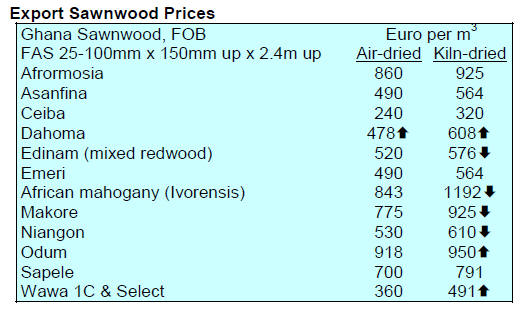
3.
MALAYSIA
Furniture Council – a bright future
for Malaysian
manufacturers
Malaysia is one of the world’s top 10 furniture exporters.
The global furniture market is expected to grow between
3% and 5% in the next five years. To ensure the country
remains competitive the Malaysian Furniture Council
(MFC) has developed a five-year plan for the furniture
sector.
The theme of the plan is challenging, “Furnishing
Malaysia with Exciting Diversity and Unlimited
Opportunities” which seems to suggest more emphasis
will be on domestic designs and the domestic market.
Chua Chun Chai, MFC President, says there is a bright
future for Malaysian manufacturers and the long-term
strategy will cement these opportunities. The MFC plan is
in line with the Government’s National Timber Industry
Policy (NAITP) where furniture exports are set to reach
RM16 billion by 2020.
In preparing the plan the MFC conducted a survey of
members and the results of this have just been made
available. MFC has 245 members employing around 8,000
Malaysians and 23,000 foreign workers. Nationwide it is
estimated there are there are around 17,000 Malaysians
and around 50,000 foreign workers employed in the
furniture manufacturing sector.
Large areas of natural forest cleared ostensibly for oil
palm plantations
The Sarawak State government has reported that no new
felling licenses will be issued as it moves to ensure the
natural forest in the State remains intact. Sarawak Chief
Minister, Abang Johari Tun Openg, lamented the clearing
of large areas of natural forest ostensibly to create oil palm
plantations.
He has called for a moratorium on issuance of oil palm
licenses except for areas classified as Native Customary
Rights Land. He said the State government is determined
to eliminate illegal logging.
http://www.theborneopost.com/2018/07/18/swak-govt-to-stopissuing-
new-timber-licenses-cm/
Forestry Department and civil society to test shared
governance and responsibility
Two civil society groups, Forever Sabah and Hutan along
with WWF Malaysia have signed Memorandum of
Understanding with Sabah Forestry Department and the
forest concession holder, Anika Desiran. This MOU,
which will run for five years, is the first in Sabah for a
joint effort between the Forestry Department, the private
sector and civil society to trial shared governance and
responsibility.
Speaking to the media, John Tay, the head of WWF Sabah
said the next step will be to involve local communities, the
development of carbon neutral products and to investigate
renewable energy possibilities. Staff at the forest
concession holder, Anika Desiran, will receive training on
high conservation value monitoring and reduced impact
logging.
Is this the world’s tallest tree?
A recently discovered yellow meranti tree (Shorea
faguetiana) in the Tawau District of Sabah is said to be the
world’s tallest tropical tree at 96.9 m. It was thought that
the fertile volcanic soil and high rainfall in the area
contributed to its height growth.
See:
http://www.dailyexpress.com.my/news.cfm?NewsID=125818
Plywood prices
Plywood traders based in Sarawak reported the following
export prices:

4.
INDONESIA
Boost to Industry -
Government to offer SVLK
subsidies
Airlangga Hartarto, Minister of Industry, has indicated that
the government will provide incentives for small and
medium sized wood product and furniture manufacturers
so they can secure SVLK certification, a measure aimed at
building greater capacity in the domestic industrial sector.
Other support will include easing regulations and duties on
imported raw materials used in manufacturing especially
for export.
In welcoming the plan by government the Chairman of the
Association of Indonesian Forest Concessionaires (APHI)
attention should also be given to marketing not just
production.
He said there is a need for a coordinated effort between
entrepreneurs and the ministries of Environment and
Forestry and Industry to address promoting Indonesian
wood products to international market.
Support for the subsidy initiative was also voiced by the
Chairman of the Association of Indonesian Sawn Timber
and Wood Producers (ISWA) who said SVLK certification
adds credibility to the legality of Indonesian wood
products. The Association reminded the government that
SVLK certification is an expensive exercise and suggested
the level of subsidy be greater than that given in 2015.
While also welcoming the initiative of government the
Secretary General of the Association of Indonesian
Furniture and Handicraft Industries (HIMKI), Abdul
Sobur, reiterated that SVLK certification of both upstream
and down-stream industries is inefficient as it
doubles up the cost of certification.
His argument is that up-stream certification is enough as
automatically the products that are manufactured
automatically satisfy legality requirements. He pointed out
once again that certification for downstream industries
using certified raw material undermines competitiveness.
For more see: https://industri.kontan.co.id/news/himki-subsidisvlk-
sebaiknya-difokuskan-ke-sektor-hulu
In related news, Zulfandi Lubis Executive Director of
Indonesian Forestry Certification Cooperation (IFCC) has
warned that awareness of the importance of SVLK
certification in Indonesia is not widespread. He claimed
that most companies only apply for certification when it is
requested by the market or by an end-user.
Changes to GSP a threat to wood export target
In a recent statement the Ministry of Environment and
Forestry (KLHK) said it believes the wood products
export target for this year can be achieved. However, there
are some serious challenges ahead according to the KLHK
Director of Processing and Marketing, Rufi'ie.
One such challenge is the current review of the
Generalised System of Preference (GSP) being undertaken
by the US government as it appears there are plans to
remove woodbased panel products from the GSP list.
Rufi'ie said if that happens it will disrupt Indonesian panel
exports to the US because they will be subject to high
import duties.
In the first half of 2018 the value of Indonesian processed
wood product exports was about US$6 billion or 50% of
the 2018 export target.
Trade Minister, Enggartiasto Lukita, has indicated that the
government intends to dispatch a negotiating team to the
US to discuss the importance of the GSP to Indonesia. The
US has indicated it plans to review tariffs on over 120
Indonesian products, including textiles, plywood, and
marine products.
Indonesian cooperation with the US Forest Service
The Ministry of Environment and Forestry (KLHK) has
strengthened cooperation on forest management and
forestry with the United States Forest Service (USFS)
under the existing Participating Agency Partnership
Agreement for the period 2016-2019.
The Minister said technical assistance and expertise will
be provided by the USFS and that this will increase
capacity in some key areas such as forest conservation,
mitigation of greenhouse gas emissions, peatland
restoration, fire management and mangrove management.
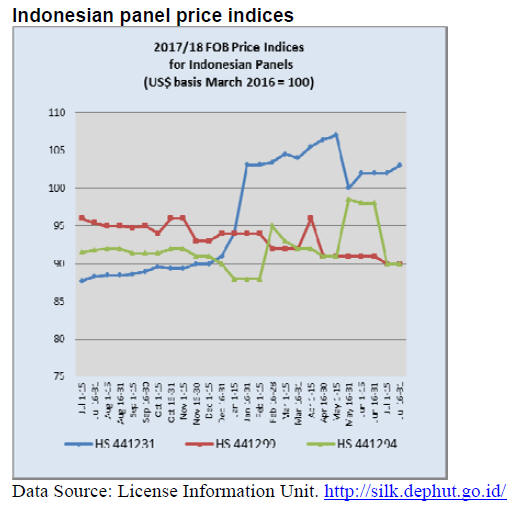
5.
MYANMAR
Mills closing for lack of logs
The local media (Voice Daily) has quoted the Secretary of
the Myanmar Timber Merchants Association, Soe Win, as
saying that about 80% of the wood processing plants in the
country have stopped operation. The reason, according to
Soe Win, is the drastic reduction in log harvests and while
the depreciation of the local currency against major
currencies is helping exporters, it has pushed up the price
of the imported raw materials used in production.
Myanmar introduced a one-year harvesting moratorium in
2016-17 and resumed harvesting this year but harvest
levels were reduced from 350,000 Hoppus tons to 15, 000
Hoppus tons for teak and from 1,400,000 Hoppus tons to
350,000 hoppus tons for non-teak timbers.
In related news, the Myanmar Forest Certification
Committee (MFCC) has said the test run of the Myanmar
certification system will soon get underway.
Huge investment planned in China-Myanmar Economic
Corridor
According to U Min Zaw Oo, Director of the Directorate
of Investment and Company Administration (DICA),
China and Myanmar have reached agreement on building
a China-Myanmar Economic Corridor, part of China’s
One Belt One Road Initiative.
China is Myanmar’s largest investment partner. Between
1988 and May of this year it had invested around US$20
billion in the country, according to DICA.
The economic corridor will run from Yunnan Province to
Mandalay in Central Myanmar and then east to Yangon
and west to the Kyaukphyu Special Economic Zone (SEZ)
according to the DICA.
For more see: https://www.irrawaddy.com/news/burma/chinamyanmar-
agree-15-point-mou-economic-corridor.html
Sombre report on business sentiment
The Myanmar Federation of Chambers of Commerce and
Industry (UMFCCI) recently released results of a survey
of enterprises in the country.
The report says that the business sentiment index has
fallen from 73 in 2016 to 49 currently, with a majority of
businesses saying the government lacks a clear economic
policy. The survey also found that the weaker sentiment
was, according to respondents, also due to high tax levels
and import restrictions and duties.
UMFCCI concluded that the private sector is losing
confidence because of the slow pace of economic reforms.
In 2017 the ruling party said it aimed to lift Myanmar into
the top 100 countries on the World Bank’s Ease of Doing
Business list but in 2018 Myanmar’s position on the list
fell. Myanmar remains the least favorable ASEAN country
in which to do business.
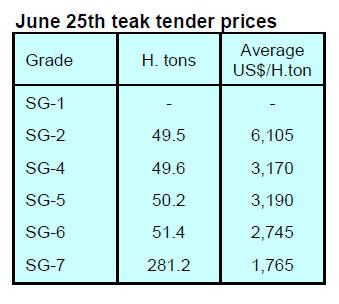
6. INDIA
Woodbased panel
price index declines in June
India’s official wholesale price index for all commodities
(Base: 2011-12=100) for June 2018 released by the Office
of the Economic Adviser to the government rose to 119.2
in June from 117.9 in May.
The annual rate of inflation, based on monthly WPI in
June 2018 was 5.77% compared to 4.43% for the previous
month. With retail prices at a five-month high due to rising
fuel prices expectations remain strong for an interest rate
increase when the Reserve Bank of India’s Monetary
Policy Committee meets in August.
The price index for ‘Manufactures of Wood and of
Products of Wood and Cork‘ group declined to 133.1 from
133.3 for the previous month due mainly to a decline in
the price of veneers. However, the price index for
blockboard and other panels rose.
The press release from the Ministry of Commerce and Industry
can be found at: http://eaindustry.nic.in/cmonthly.pdf
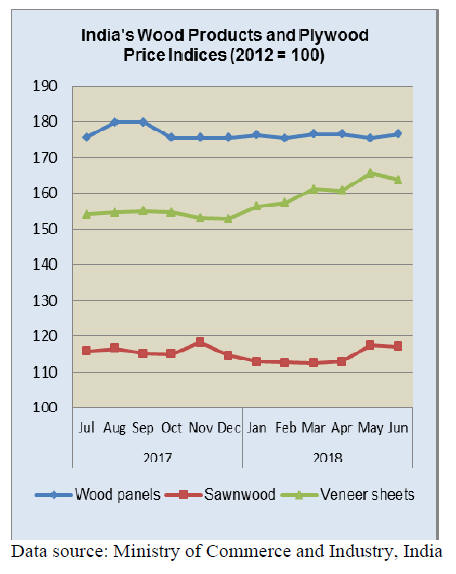
Host of items benefit from GST cut
When the Goods and Services Tax (GST) was
implemented 1 July, 2017 there were around 226 goods
attracting a 28% tax rate but over the past year the GST
Council has reduced the rate for 191 of the 226 items.
The 35 goods which will continue to attract the highest
rate include cement, automobile parts, tyres, automobile
equipment, motor vehicles, yachts, aircrafts, aerated
drinks, tobacco, cigarettes and pan masala.
Analysts say they expect that a review of the remaining
items in the high tax bracket such as televisions,
dishwashers, digital cameras, air conditioners may be
considered for a rate cut. For wood and wood products
efforts continue to secure a reduced GST rate from 18% to
12% as these wood products are essential goods.
Plantation teak
Demand for imported logs has slowed due to onset of
monsoon which impacts construction work. Traders report
that deliveries are also slowing down. The strong dollar,
rising for last three months, has pushed up landed costs
such that importers are reluctant to forward purchase.
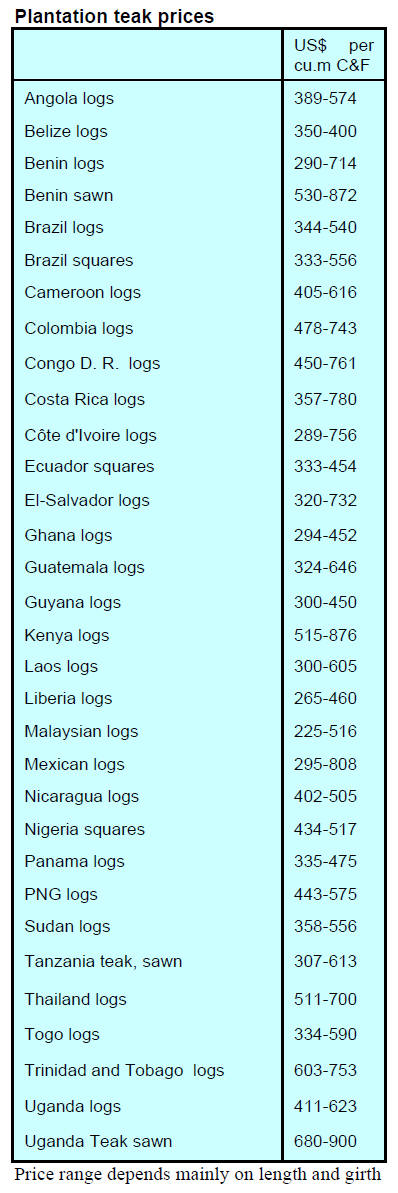
Locally sawn hardwood prices
Demand for imported hardwoods is weakening as end-user
industries such as carpenters prefer material which
requires less labour. Solid wood is being replaced by faced
panel products such as MDF and wood plastic composites,
notably for doors and frames. There are sizeable stocks of
imported hardwoods in the country but with slow demand
prices have not moved in months.
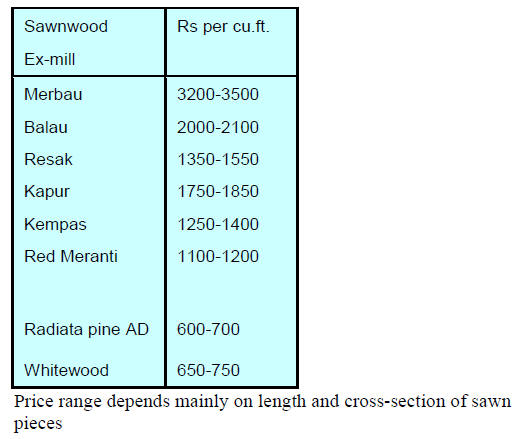
Imported sawn Myanmar teak
Indian importers who purchased large volumes of
Myanmar teak logs before the log export ban was
introduced are now stuck with high stocks of sawing
quality logs as sales of this quality are slow.
At present teak faced plywood and teak veneers are hot
items and these are being imported from China in large
quantities.
Indian veneer manufacturers are hoping that eventually
Myanmar will allow the export of high quality teak veneer
logs so as to maximise export earnings from these top
quality logs.
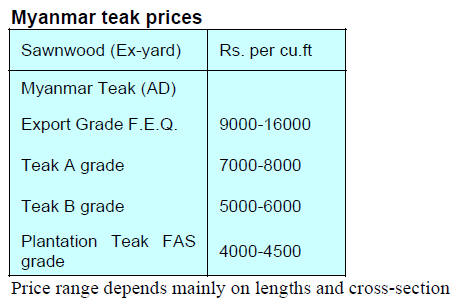
Prices for imported sawnwood
Traders report that demand for imported sawnwood is
current low and that prices for imported sawnwood (KD
12%) ex-warehouse remain unchanged from two weeks
earlier.
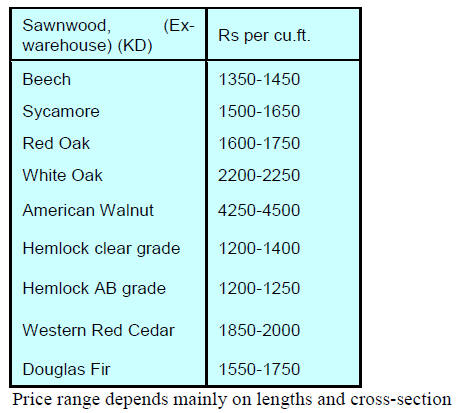
Domestic plywood update
With the beginning of the monsoon planting season many
mill workers return to their home villages which affects
plywood production. Production will only get backto
normal when the workers return.
During the pre-monsoon time many mill workers go to
their villages to help prepare fields for monsoon sowing.
The workers stay away for between 4-8 weeks and
plywood mill production suffers. With onset of
monsoon rains the workers return to work as they are not
needed for any further farm work. At this point factories
are able to resume normal production. This is annual
problem in India.
The weak rupee exchange rate has increased the costs of
imported raw materials especially resins and other
chemicals as well as face veneers. As plywood production
has begun to rise this is beginning to have an impact on
demand for logs such that prices are firming.
Plywood manufacturers are contemplating increasing
prices by between 8 to 10% to compensate for rising costs
but the market may resist a one-step rise so a decision was
made to phase price increases to gauge end-user reactions.
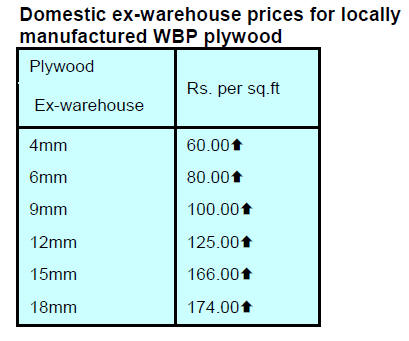
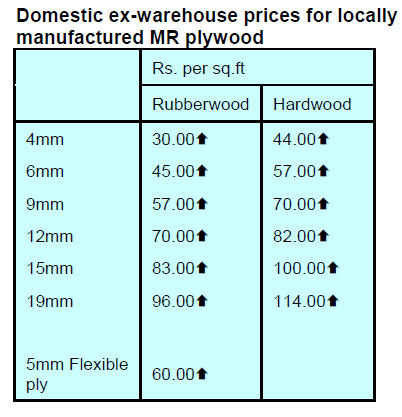
7. BRAZIL
Expanding domestic markets for
producers in Mato
Grosso
At the ForMóbile Trade Show for suppliers of furniture
held in São Paulo in early July entrepreneurs associated
with the unions that make up the CIPEM (Center for
Timber Producers and Exporters of Mato Grosso State)
had the opportunity to talk directly with buyers from all
over Brazil. During the event, more than 1,500 people
visited the CIPEM´s stand.
Foreign buyers also attended the event in search of
suppliers of tropical timber with guarantees of timber
origin. A buyer from the Dominican Republic said having
access directly to a supplier provides for greater
competitiveness in the market.
Mato Grosso State, a major tropical timber producer state
in the Amazon region, currently has more than 3 million
hectares of forest area under sustainable forest
management. In 2017, 3.5 million cubic metres were
traded worth R$241 million. Of the total production in the
state around 70% was for domestic consumption the
balance was exported. According to CIPEM, the
expectation is that exports will grow around 15% over the
next five years.
The high standard of timber quality and the strict control
of timber origin in Mato Grosso are factors that guarantee
the continuity of the standing forest even with an increase
in demand, says CIPEM.
Digital technologies in support of sustainable logging
The Brazilian Agricultural Research Corporation
(EMBRAPA) and partner institutions have invested in
development of drones and digital tools to monitor the
sustainable forest management of Brazilian forests.
One of these models is the Digital Model of Forest
Logging – Modeflora (Modelo Digital de Exploração
Florestal) developed by EMBRAPA to improve the
planning of forest operations.
The brand was registered with the National Institute of
Industrial Property in 2015 and is currently being applied
in forest management plans in the Amazon region.
Another leading geo-technology available and useful for
sustainable forest management is LiDAR (Light detection
and ranging). This is an optical remote sensing technology
that scans an area from an airplane generating a 3D model
of the area.
These two technologies, combined with the use of drones
are being used in a complementary way in sustainable
forest management in Brazil.
Export update
In June 2018 the total value of Brazilian exports of woodbased
products (except pulp and paper) increased 23%
compared to June 2017 from US$213.9 million to
US$263.6 million.
The value of pine sawnwood exports increased 34%
between June 2017 (US$34.0 million) and June 2018
(US$45.5 million). The volume of exports increased 29%
over the same period, from 166,600 cu.m to 214,200 cu.m.
Tropical sawnwood exports increased 41% from 33,700
cu.m in June 2017 to 47,400 cu.m in June 2018. In terms
of value, exports increased almost 27% from US$15
million to US$19 million, over the same period.
Pine plywood exports increased 63.4% in value in June
2018 in comparison with the value in June 2017, namely
from US$37 million to US$61 million. Export volumes
rose 34% over the same period, from 129,400 cu.m to
173,700 cu.m.
As for tropical plywood, exports fell around 10% in June
2018 from 13,300 cu.m (US$5.3 million) in June 2017 to
12,000 cu.m in June 2018.
In June 2018 there was a sharp rise in wooden furniture
exports with export values rising from US$36.9 million in
June 2017 to US$49.2 million in June 2018, 33% increase.
Defending the interests of timber industry
The Brazilian Mechanically Processed Timber Industry
Association (ABIMCI) recently participated in a meeting
of the US-Brazil Business Council which aims to assist
Brazilian companies expand business in the United States.
At the meeting the activities of the Council in defence of
the commercial interests of Brazilian and North American
companies were discussed.
At the meeting with the Brazilian Industries Coalition
(BIC) in Washington, information on possible changes to
the US Generalised System of Preferences programme was
provided. Discussions centred on how to protect Brazilian
wood products from disruptions in GSP allocations.
Brazilian furniture exports increase
Exports of Brazilian furniture increased 10% between
January and May 2018 compared to the same period of
last year and were worth US$262.6 million, a growth of
5.2% compared to the same period last year. This data was
released by the Brazilian Furniture Industry Association
(Abimóvel) and the Brazilian Trade and Investment
Promotion Agency (Apex-Brazil).
The survey also revealed that in the past 12 months at least
85% of exports were of wooden furniture. Exports to the
United States accounted for just over 26% of all wooden
furniture exports up almost 8% year on year.
The United Kingdom accounted for a further 11% of
exports followed by Argentina (10%). The southern states
of Brazil are the largest exporters of furniture with the
states of Santa Catarina taking a 38.5% share, Rio Grande
do Sul 27% and Paraná 15%. The three states accounted
for almost 80% of all wooden furniture exports between
January and May 2018.
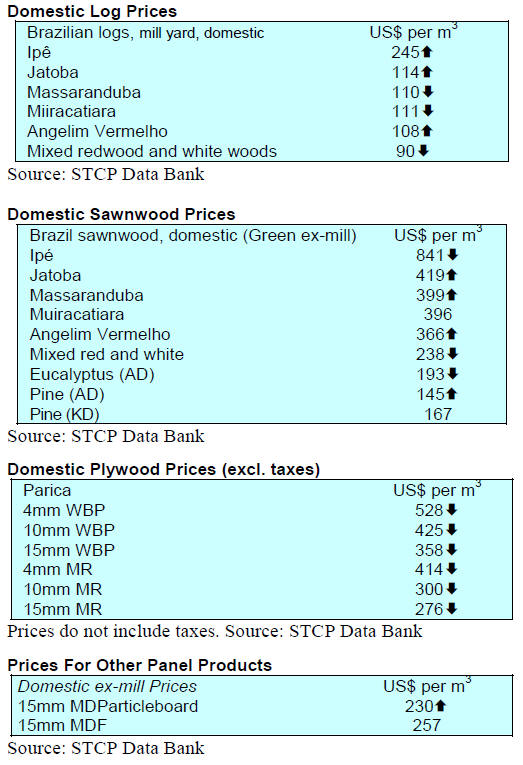
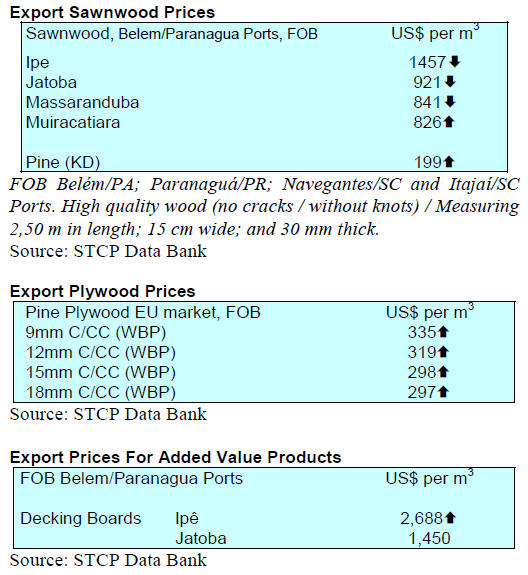
8. PERU
New software for wood identification
explained
The Thünen Institute for timber research in Germany in
partnership with the institutes for Technological
Innovation CITEmadera and CITEforestal in Brazil
recently arranged a ‘Wood Identification Workshop: Basic
Concepts and Practical Exercises’ the purpose of which
was to strengthen the capacity in the use of new software
for the identification of timber species.
The course was developed by a specialist in anatomy and
wood structure in the Thünen-Institut. in understanding the
potential of this type of tools was considered an important
element in the development of wood processing sector in
the country.
Sharing experiences on building capacity amongst
informal timber sector workers
It has been estimated that around 880,000 people are
employed in the timber sector of Peru of which the vast
majority are casual, untrained workers. Of the total
workforce around 16% are employed in forest
management, 12% in primary conversion and 72% in
secondary conversion. Of the latter, the manufacture of
furniture accounts for around half of the employed
workforce.
The importance of the timber sector in generating rural
employment is often overlooked and there are few training
opportunities for migrant informal workers.
In order to contribute to improving the skills of workers in
the informal segment of the timber sector, representatives
of the Ministry of Production and the Technological
Institute of Production through the CITEmadera visited
Quito and Cuenca in Ecuador where they participated in
discussion with their peers from the public and private
sectors.
Topics such as the design and implementation of
vocational training were discussed; the promotion of the
wood and furniture sector through increased of labour
competence and articulation between the public and
private sector in the execution of technical training
requirements.
SERFOR celebrates 4th anniversary
The National Forest and Wildlife Service (SERFOR) in
the Ministry of Agriculture and Irrigation has over the past
four years undertaken promoting of sustainable
management of the nation’s flora and fauna so as to
contribute to the generation of national well-being.
In order to strengthening the management of Regional
Governments responsible for forest and wildlife
management SERFOR has established liaison offices in
Ucayali, Loreto, Madre de Dios and San Martín and
intends to expand to other regions.
The SERFOR was created under the Forestry and Wildlife
Law, No. 29763 and begin to function in 2014 SERFOR is
the National Forest and Wildlife Authority in charge of
determining strategies, plans, programmes and procedures
related to the management, administration and sustainable
use of forest and wildlife resources. It has 13 Forestry and
Wildlife Technical Administrations (ATFFS) that operate
in 15 departments of the country.
